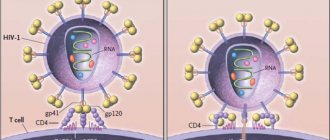The ability to adapt to the environment is an innate “skill” of the human psyche, necessary for survival. Adaptation disorder manifests itself in the fact that a person cannot perceive new events of a negative nature (trauma, stress, life difficulties), meeting the novelty with a certain set of pathological reactions.
In ICD-10, this disorder is listed under code F 43.2 and is described as a disorder of mental functions and behavior.
Articles on the topic
- Necessary help for teenagers with autism 09/21/2021
- Stages of alcoholism in women: main signs 06/24/2021
- Split personality: symptoms and signs of the disease in women 06.24.2021
- The main symptoms of nervous exhaustion in women and treatment rules 06/09/2021
Due to the inability to “digest” life changes, an individual may experience the following symptoms:
- severe emotional experiences;
- inappropriate actions;
- reluctance to contact people and voluntary isolation;
- decrease in social activity.
Triggers for triggering adaptation disorder are various traumatic situations:
- divorce;
- death of a loved one;
- exams;
- job loss;
- natural disasters;
- protracted conflicts and so on.
Mental adjustment disorder is a reversible process and can be successfully treated.
What is adjustment disorder?
Research shows that 6.9% of adults are diagnosed with an adjustment disorder each year. A person may have adjustment disorder after a stressful event or life change. Common activation events include relationship problems, job loss, death of a loved one, or moving to another location. Everyone is different, so the triggering events for adjustment disorder may vary.
Adjustment disorder with anxiety is different from stress. The first occurs when a person has difficulty coping or adapting to a particular change in circumstances. Typically, adjustment disorder manifests itself emotionally and mentally, but people who experience it may also have physical symptoms.
A person may have adjustment disorder if they experience symptoms following a stressor. Research shows that diagnostic criteria for adjustment disorder with anxiety include symptoms lasting about 6 months. If symptoms persist after this period, this is a different diagnosis.
Stress and adjustment disorders
About the article
26582
0
Regular issues of "RMZh" No. 11 dated May 12, 2009 p. 789
Category: Neurology
Author: Vorobyova O.V. 1 1 Federal State Autonomous Educational Institution of Higher Education First Moscow State Medical University named after. THEM. Sechenov Ministry of Health of Russia (Sechenov University), Moscow, Russia
For quotation:
Vorobyova O.V. Stress and adjustment disorders. RMJ. 2009;11:789.
Stress, anxiety and depression are significant factors in the development and progression of a large number of diseases - from asthma, cardiovascular disease to cancer and HIV infection. This link between stress and neurobiological changes leading to mental and physical disorders has been well documented in the medical literature over the last century.
Stress is a state of tension in the adaptation mechanisms. The concept of “stress” was first described by TR Glynn in 1910 and, thanks to the classic works of H. Selye (1936), became firmly established in everyday life. Stress in a broad sense can be defined as a nonspecific reaction of the body to a situation that requires greater or lesser functional restructuring of the body, corresponding adaptation to the given situation. Not only negative events, but also psychologically favorable events require adaptive costs and, therefore, are stressful. It is important to keep in mind that any new life situation causes stress, but not every one of them is critical. Critical situations are caused by distress, which is experienced as grief, unhappiness, exhaustion of strength and is accompanied by a violation of adaptation, control, and interferes with the self-actualization of the individual. All critical situations, from relatively easy to the most difficult (stress, frustration, conflict and crisis), require a person to perform various internal work, certain skills to overcome them and adapt to them. The degree of severity of a reaction to stress of the same strength can be different and depends on many factors: gender, age, personality structure, level of social support, various circumstances. Some individuals with extremely low stress tolerance may develop a painful condition in response to a stressful event that is not beyond normal or everyday mental stress. Stressful events that are more or less obvious to the patient cause painful symptoms that disrupt the patient’s usual functioning (professional activities and social functions may be disrupted). These painful conditions are called adaptation disorders. Clinical picture The disease usually develops within three months after exposure to a psychosocial stressor or multiple stresses. The clinical manifestations of adaptive disorder are extremely variable. Nevertheless, psychopathological symptoms and associated autonomic disorders can usually be distinguished. It is vegetative symptoms that force the patient to seek help from a doctor. Feelings of heat or cold, tachycardia, nausea, abdominal pain, diarrhea and constipation can be a consequence of the autonomic response to stress. An autonomic response inadequate to the stimulus (stress) is the basis for many psychosomatic disorders. Knowledge of the pattern of the autonomic response to psychological stress allows us to understand stress-related diseases (Table 1). The autonomic response to stress can be a trigger for somatic illness (psychosomatic illnesses). For example, the cardiovascular response to stress increases myocardial oxygen consumption and can cause angina in individuals with coronary artery disease. Most patients present exclusively organ complaints, based on their own or cultural ideas about the importance of a particular organ in the body. Autonomic disorders can manifest themselves predominantly in one system (usually the cardiovascular system), but in most cases, active questioning of the patient allows us to identify less pronounced symptoms from other systems. As the disease progresses, autonomic disorders acquire a distinct multisystem character. It is natural for autonomic dysfunction to replace one symptom with another. In addition to autonomic dysfunction, patients quite often experience sleep disorders (difficulty falling asleep, light shallow sleep, night awakenings), asthenic symptom complex, irritability, and neuroendocrine disorders. Mental disorders obligately accompany autonomic dysfunction. However, the type of mental disorder and its severity vary widely among different patients. Mental symptoms are often hidden behind a “façade” of massive autonomic dysfunction and are ignored by the patient and those around him. The doctor’s ability to “see” psychopathological symptoms in a patient, in addition to autonomic dysfunction, is decisive in the diagnosis of adaptation disorders. Most often, maladjustment is characterized by an anxious mood, a feeling of inability to cope with the situation, and even a decrease in the ability to function in everyday life. Anxiety is manifested by a diffuse, extremely unpleasant, often vague feeling of fear of something, a feeling of threat, a feeling of tension, increased irritability, and tearfulness (Table 2). The patient experiences “anticipation anxiety,” a future-oriented preoccupation that reflects a readiness to cope with upcoming negative events. Sometimes the patient expresses fears regarding real and/or perceived unpleasant events. For example, to those around him, such a patient may express various catastrophic thoughts related to the global economic crisis: “... and by spring in our country everyone will eat exclusively black bread and water. And there will be no cars on the street - there will be no money to refuel. Can you imagine – empty streets...” If the listener is also prone to anxiety, then the patient’s words have fallen on fertile soil, anxiety begins to cover (“infect”) the patient’s environment. This spread of anxiety is especially typical during periods of social disadvantage. At the same time, anxiety in this category of patients can manifest itself as specific fears, primarily concerns about their own health. Patients are afraid of the possible development of stroke, heart attack, cancer and other serious diseases. This category of patients is characterized by frequent visits to the doctor, numerous repeated instrumental studies, and a thorough study of the medical literature. Adaptation disorder with depressive mood is characterized by a low background mood, sometimes reaching the level of melancholy, and a limitation of usual interests and desires. Patients express pessimistic thoughts regarding current events, uniformly negatively interpret any events, blame themselves and/or others for their inability to influence events. The future seems to them exclusively in black colors. This category of patients is characterized by mental and physical exhaustion, decreased concentration, memory impairment, and loss of interests. Patients note that it is difficult for them to gather their thoughts, any undertaking seems impossible, and a strong-willed effort is required to maintain everyday activities. They note difficulty concentrating on one issue, difficulty in making decisions, and then in putting it into practice. Patients, as a rule, are aware of their failure, but try to hide it, citing various reasons to justify their inaction. The main symptom of depression, low mood (sadness), is often actively denied by the patient or considered by him as an insignificant secondary symptom associated with somatic pathology. In some cases, depressive affect may be hidden behind additional mental symptoms: irritability, hypochondriacal ideas, anxiety, phobic symptoms. More than half of patients with adjustment disorders do not realize that they suffer from a mental disorder and present only somatic complaints. When a doctor tries to discuss the patient’s emotional experiences, the latter almost always shows a negative reaction. These patients are usually extremely sensitive to any hint that their complaints are “unfounded,” so all questions regarding mood and other mental symptoms should be asked in an extremely friendly manner. It is pointless to argue with such patients, and it can also traumatize them. A narrowing of interests and loss of pleasure (the second most important symptom of depression) may also be ignored by the patient; or certain life limitations are considered by him as an inevitable consequence of a somatic illness. In such cases, to understand the reasons for the patient’s maladjustment, objective information from close relatives is necessary. The most important stage in the (positive) diagnosis of maladjustment in general somatic practice is to identify the characteristic features of complaints associated with depression and their characteristic environment. Somatic complaints, pathogenetically associated with depression and anxiety, are primarily characterized by polymorphism, variability, and inconsistency (there is no logical clinical connection between the complaints). Patients who have unexplained somatic symptoms should primarily be considered at risk for adjustment disorder. The risk is especially high in patients who have several somatic symptoms and evaluate their condition as very bad in the absence of objective organ pathology. These patients tend to report feelings of dissatisfaction after a visit to the doctor, and it is these patients that doctors most often regard as “difficult.” Most often, these complaints are manifestations of: 1) autonomic dysfunction (mainly in the cardiovascular system, gastrointestinal tract, respiratory system); 2) chronic pain syndrome (cardialgia, cephalgia, back pain); 3) hysterical disorders (lump in the throat, tremor, dizziness, gait disturbance, senestopathic paresthesia). Specially conducted studies have shown that, in addition to actual (“organ”) complaints for the patient, the following disorders are most often observed: • dyssomnia (and the classic “morning insomnia” with characteristic early awakenings does not always occur; there may be difficulties falling asleep, shallow sleep or hypersomnia, which does not bring a feeling of morning vigor); • a feeling of severe fatigue, which already precedes mental or physical stress; • irritability, grumpiness, low self-esteem, feelings of self-pity, feelings of hopelessness, exaggeration of the severity of a real somatic illness; • difficulty concentrating when necessary, which may be regarded by the patient as memory impairment; • sexual dysfunctions, most often decreased libido; • change in appetite (lack of appetite/increased appetite) with weight change of more than 5% per month; • painful health, accompanied by unpleasant bodily sensations, vague forebodings with a peak of symptoms in the morning; • rejection of negative physical examination results. The described depressive symptoms surrounding current complaints must be identified through active questioning, since, as a rule, it is difficult for patients to verbally express their state of mind and they “prefer” to describe to the doctor only understandable somatic sensations. Many of the described accompanying symptoms relate to motivational disturbances in patients with adjustment disorder with anxious and/or depressive mood. This is a predominance of feelings of fatigue, weakness, eating disorders (fluctuations in appetite, including during the day). Sleep disorders may include difficulty falling asleep, shallow sleep with frequent awakenings, frightening dreams, early awakenings with unexplained anxiety, dissatisfaction with sleep, and lack of rest after sleep. Disturbances in the sphere of intimate relationships in men can manifest themselves as premature ejaculation and a secondary decrease in libido; in women - a decrease in the frequency and degree of orgasm, as well as interest in sexual activity. All of the above disorders are often not assessed as somatic manifestations of stress, and further increase the feeling of helplessness. The consequence of painful symptoms is social maladjustment. Patients begin to cope poorly with their usual professional activities, they are haunted by professional failures, as a result of which they prefer to avoid professional responsibility and refuse the opportunity for professional growth. A third of patients completely stop their professional activities. Communication disorders complicate normal social activity and lead to conflicts in personal life (Table 3). Currently, diagnostic criteria for adaptation disorders have been proposed (Table 4). In ICD-10, related disorders are designated as adjustment disorder (F43.2). Characteristics of the stressor factor and response Stressful events that cause maladjustment disorder are events that do not reach the quantitative and qualitative characteristics of extreme stress, but cause the need for psychological adaptation. Most often, patients indicate conflicts in interpersonal relationships, in particular marital conflicts, divorce, travel, as well as work problems. Women react painfully to stressful events in their personal lives, while for men the most significant factor is professional failures. An individual's illness can become a significant stressor regardless of gender. The consequences of the disease, possible disability, threat of pain, severe disability, fear of becoming a heavy burden for family members can lead to the development of a maladaptive disorder that requires medical intervention. The increase in psychopathological manifestations and somatic disorders in critical years of social development indicates the pathogenic influence of public social factors on health. “Exorbitant environmental pressure,” an unstable society that places increased demands on people, become chronic stressors. The constant threat posed by the environment and the person's inability to cope or manage future negative events leads to distressed anxiety and autonomic activation. Some researchers even identify social stress disorders. The term “social disease” was first proposed by A.M. Rosenstein in 1923. Since then, the pathogenic role of social stressors has been convincingly proven. It is believed that threat stress more often causes anxiety reactions, and loss stress – depressive reactions. Important factors in the development of adaptive disorders are the amount of stress and their individual significance. It is well known that given equal levels of stress, some people get sick and others do not. Factors that predispose to the development of the disease in response to stress are now known. These factors include a person's personality characteristics, defense mechanisms and strategies for coping with stress, and the presence or absence of social support. A person’s preliminary prognostic assessment of a stressful event is also important. An exclusively negative assessment of a stressful event and exaggeration of the danger cause greater harm to the body. Psychological or biological stress causes a normal (physiological) response of the body in the form of a psychophysiological reaction, manifested by anxiety symptoms and autonomic dysfunction, which is caused by a cascade of neuroendocrine changes. In response to stress, corticotropin-releasing factor (CRRF) is released from the hypothalamus, which stimulates the anterior pituitary gland, where ACTH begins to be synthesized intensively. ACTH, in turn, stimulates the release of glucocorticoids (cortisol) from the adrenal cortex. The sympathetic nervous system is activated in all forms of stress, and, among other things, adrenaline is released from the adrenal medulla into the blood, which serves as an active stimulator of ACTH secretion by the pituitary gland and enhances the action of other mechanisms that activate the function of the pituitary gland under stress (Table 5). Normally, these processes soon stop, since the hypothalamic-pituitary-adrenal system is regulated by a feedback mechanism. Glucocorticoid receptors of the anterior pituitary gland play a key role in inhibiting the hypothalamic-pituitary-adrenal axis and further secretion of glucocorticoids under stress. This psychovegetative response is very important for overcoming an acute physical threat. But in modern society, stress is more often of a psychosocial nature, and this type of response is more likely to cause harm than benefit to health. Modern society is characterized by a fast pace of life, an abundance of information, a requirement for high productivity, efficiency, constant competition, a decrease in the share of hard physical labor, and a lack of time and opportunity for rest and recovery. The stress on the nervous system and mental fatigue increase. Inadequate rest and recovery causes more harm than absolute stress levels. Previous trauma plays a special role. Chronic psychosocial stress, even of low intensity, prolongs the changes caused by acute stress, causing prolonged ACTH stimulation and depletion of the adrenal cortex. For example, in conditions of uncontrolled protracted stress in healthy volunteers, an increase in plasma concentrations of norepinephrine and ACTH is observed. On the other hand, premorbide also affects adaptive disorders. Presumably, the breakdown of the reverse mechanism of inhibition of glucocorticoid secretion leads to protracted psychophysiological reactions to stress. It is possible that patients with anxiety and/or depression have a certain defect in the feedback mechanism. At least, there is convincing evidence that anxious personalities are characterized by a certain psychobiological vulnerability, characterized by a super -chocious neurobiological reaction to life stresses. Clinical anxiety, when increasing this vulnerability or the severity of current stressful factors, can progress to depression. The pathogenic role of ordinary stress begins to manifest itself with its prolonged effect on people with low stressfulness, possessing such personal features as nihilism, anxiety, social alienation, and improvingiveness, which have insufficient social support. Pathogenic is stress during periods of hormonal and psychophysiological restructuring (puberty, the onset of sexual activity, pregnancy and childbirth, abortion, menopause). The line between the “normal” response to stress and pathological anxiety disorder is often very blurry and it is difficult for a person to understand when it is necessary to seek professional help. These subsindromically expressed alarming disorders are most difficult for diagnosis, often remain absurd, while having an extremely negative impact on the quality of life of the patient and the people around him. At least, you should consult a doctor when anxiety about ordinary events is not amenable to control. For example, when, in addition to nervousness, fussiness, impaired concentration, irritability, sleep disturbance, dizziness, tachycardia, epigastric discomfort, dry mouth, sweating, headache, chills and other symptoms of autonomic dysfunction are observed. Treatment despite the bondness of autonomic dysfunction and the often masked nature of emotional disorders, the basic method of treating adaptation disorders is psychopharmacological treatment. The therapeutic strategy must be built depending on the type of dominant disorder and the degree of its severity. The choice of the drug depends on the severity of the level of anxiety and the duration of the disease. If painful symptoms exist for a short time (up to two months) and slightly disrupt the functioning of the patient, then both medicinal (anxiolytic therapy) and non -changing methods can be used. Non -valuable therapy is, first of all, the possibility of patients expressing their fears in an atmosphere of psychological support that the doctor can provide. Of course, the professional help of a psychologist can activate the methods of adaptation characteristic of the patient. Medicinal treatment methods include primarily tranquilizing drugs. Benzodiazepine anxiolytics are used to stop acute symptoms of anxiety and should not be used for more than 4 weeks due to the threat of forming a dependence syndrome. With a short -term subsindromic or mild anxious adapt disorder, vegetable soothing fees or drugs based on them, antihistamines (hydroxyzine) are used. For many years, Valerian has been used in traditional medicine due to hypnotic and sedative effects and to date remains a very popular medicine. Particularly successful were drugs containing valerian and additional phyto -extracts that enhance the anxiolytic effect of valerian. The drug Persen, which, in addition to valerian, contains widely used, the lemon balm and mint extract, which enhances the anxiolytic effect of valerian and adds an antispasmodic effect. Particularly proven in the treatment of subsindromic alarming and soft alarming disorders of Persus - containing 125 mg of valerian extract in a capsule versus 50 mg in a tablet form, due to which the Persus -fort provides a high and rapid anxiolytic effect. The spectrum of the use of Perseen - in the practice of the clinician is extremely wide - from the use in monotherapy for the treatment of subsindromic and soft alarming disorders to a combination with antidepressants for leveling anxiety with anxious and depressive disorders. There are no clear recommendations for the duration of the treatment of soft and subsindromic alarming syndromes. Nevertheless, most studies have proved the benefits of long -term therapy courses. It is believed that after the reduction of all symptoms, at least 4 weeks of drug remission should pass, after which an attempt is made to cancel the drug. On average, treatment with sedative plant fees is 2-4 months. The preparations of the first stage of choice for the treatment of chronic anxiety disorders are selective serotonin requa inhibitors (SIOS). In case of adaptation disorders, the question of the prescription of the SIOS arises in case of risk of chronic disorder (progression of symptoms of more than three months) and/or the risk of adaptive disorder into clinical forms of psychopathology. In addition, an indication for the appointment of antidepressants is an adaptation of adaptation with an alarming -depressive mood or the dominance of a depressive mood. Many drugs used to treat mood disorders, anxiety and sleep disturbances can be poorly tolerated by patients due to side effects, which ultimately leads their effectiveness. Official preparations of plant origin, having significantly less side effects, can be considered as alternative therapy or used to enhance the effectiveness of prescription drugs (in particular, with intolerance to tranquilizers and antidepressants).
Content is licensed under a Creative Commons Attribution 4.0 International License.
Share the article on social networks
Recommend the article to your colleagues
Adjustment disorder - symptoms
In people who experience chronic adjustment disorder, symptoms last longer. If the stressor persists, symptoms are also likely to be long-lasting. Common symptoms of adjustment disorder include:
- difficulty concentrating
- memory loss
- feeling overwhelmed with daily activities
- feeling restless or anxious
- fatigue
- muscle twitching or trembling
- difficulty sleeping or insomnia
- frequent crying
- loss of appetite
- suicidal thoughts
Symptoms of adjustment disorder with anxiety
People who experience chronic adjustment disorder may have symptoms for a longer period of time. If the stressor persists, symptoms are also likely to be long-lasting. Common symptoms of adjustment disorder include:
- difficulty concentrating;
- memory loss;
- feeling overwhelmed by daily activities;
- feeling restless or anxious;
- fatigue;
- muscle twitching or trembling;
- difficulty sleeping or insomnia;
- frequent desire to cry;
- loss of appetite;
- suicidal idea.
How are the symptoms similar to anxiety?
People who experience anxiety may have generalized anxiety disorder. While symptoms are similar to adjustment disorder, generalized anxiety disorder is sequential and often not related to a specific, identifiable event.
There are some symptoms that occur with both anxiety disorder and adjustment disorder. Symptoms of anxiety often include the following:
- feeling hopeless or sad;
- changing sleep patterns;
- feeling restless or nervous.
Adjustment disorder in children
Adjustment disorder can occur in both adults and children.
Some children may be resistant to changes in life, while others have difficulty coping with change. With adjustment disorder, a child's mood or behavior changes. When children experience adjustment disorder, it is often associated with separation anxiety. Common causes of adjustment disorder in children include:
- transfer to another school
- moving to another house
- a parent or close relative has health problems
- parental divorce or change in household circumstances
- death of a pet
- bullying at school
Symptoms of adjustment disorder in children may include:
- abdominal pain
- headache
- different behavior at school and at home
- perceived as “naughty” behavior
- nocturnal enuresis
Research shows that “disobedient” behavior may be a manifestation of difficulty seeking change.
Treatment includes psychotherapy or medication. Children benefit from daily exercise, fresh air, meditation, or simply talking with a trusted adult.
If a child has an anxiety disorder, symptoms should not be long-lasting. However, if they persist, the child may have GAD or depression. In these cases, it is worth consulting with a psychiatrist if there are concerns about the child’s health.
Diagnosis of adjustment disorder
The criteria for determining the disease are:
- identification of psychological trauma preceding the onset of disorders;
- symptoms typical of an anxiety or affective disorder, but of lesser severity;
- onset within 1-3 months, duration no more than six months after psychotrauma.
Differential diagnosis is carried out with the following disorders:
- depressive disorder;
- anxiety disorder;
- personality disorder.
To obtain an accurate diagnosis, consultation with a psychiatrist or psychotherapist is required. If necessary, consultations with other specialists are carried out.
Adjustment disorder and PTSD
Similar symptoms are observed in both adjustment disorder and post-traumatic stress disorder (PTSD). However, these are two distinct conditions with different treatments. The main difference between adjustment disorder and PTSD is that adjustment disorder is caused by activation by a stressful event or environmental change. In contrast, PTSD often occurs due to an extremely traumatic event, such as military combat, sexual assault, and abuse. Symptoms of PTSD may also include flashbacks of the event, avoidance of reminders of the event, or long-term psychological symptoms such as feelings of guilt.
Symptoms in children
Symptoms of adjustment disorder may vary depending on the person's age. Children and adolescents have more behavioral symptoms, such as disruptive behavior. Adults experience more severe depressive states.
Children experience:
- sleep problems
- cries often
- avoids or does not want to go to school
- isolates himself from friends and family
- starts fights
- irritability
- vandalism
- hostility
- depression and anxiety
Adjustment disorder and depression
The last 50 years of research show that doctors define depression as difficulty regulating emotions. While adjustment disorder is very similar to depression, the cause and duration of symptoms differ.
Adjustment disorder usually lasts up to 6 months and is caused by a specific change in circumstances. Depression is longer lasting and can be caused by environmental, psychological or genetic factors. Doctors sometimes call adjustment disorder situational depression because the symptoms may be similar but may not last as long as depression.
Types of adjustment disorder
There are 6 different types of adjustment disorders, which doctors diagnose based on the presence of symptoms:
1 With anxiety: feeling nervous, restless, or separation anxiety.
2 With a depressed mood: hopelessness, hopelessness, or frequent tears.
3 With anxiety and depressed mood: a combination of the above symptoms.
4 With a violation of behavior: violation of the rights of others, social norms and rules.
5 With disturbances of emotions and behavior: a combination of all of the above types of adaptation disorder.
6 Uncertain: symptoms that do not fit into any of the above categories.
Differences from PTSD
People with adjustment disorder may have a cluster of symptoms that overlap with those of other conditions.
These include:
- post-traumatic stress disorder (PTSD)
- depression
- anxiety
People similarly experience depressed mood and anxiety. However, adjustment disorder has a different set of criteria than other mental health conditions, allowing doctors to differentiate between them.
PTSD usually occurs after a life-threatening event, such as war or physical attack, as opposed to adjustment disorder, which is caused by major life changes or severe stress. PTSD often lasts longer than adjustment disorder and is more complicated if the person has experienced prolonged or repeated trauma rather than a single event.
Adjustment disorder is difficult to distinguish from depressive disorders. Doctors can use a tool called the Diagnostic and Statistical Manual of Mental Disorders, which lists the main criteria. Adjustment disorder is also listed in the International Medical Classification and is known as ICD-10.
Treatment of adjustment disorder
Psychotherapy, or talk therapy, can help people overcome unpleasant conditions. The patient can meet one-on-one with a therapist to work through emotional and mental issues. Others may find group therapy helpful for developing social and interpersonal skills.
One approach involves cognitive behavioral therapy (CBT). This technique focuses on changing mindsets to help people solve problems and develop a positive attitude.
Children or family members with adjustment disorder may benefit from family therapy and will work with a therapist to improve communication, interaction, and support. In some cases, your doctor may prescribe medication along with psychotherapy for symptoms such as depression and anxiety. However, it is not usually the first line of treatment for adjustment disorders.
Summary
Adjustment disorder is an extreme reaction to a stressful life event or significant change. People of any age are susceptible to it. Changes in family structure, divorce, or moving can all cause adjustment disorder.
People may feel depressed, anxious or hopeless, often become withdrawn, become more tearful than usual, or have trouble sleeping. Children and adolescents may exhibit disruptive behavior.
Patients may want to see a doctor if they experience symptoms of adjustment disorder. The doctor may refer them to a mental health professional, such as a therapist. Talk therapy, family support and care greatly alleviate the condition of the victim.










